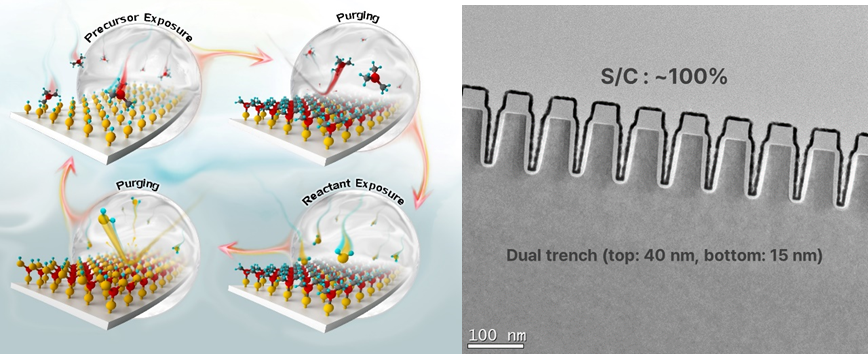Researchers at UNIST’s Graduate School of Semiconductors Materials and Devices Engineering and Department of Materials Science and Engineering, under the direction of Professor Soo-Hyun Kim, have made significant strides toward the discovery of precisely controlled atomic layer deposition (ALD) incorporation of precious metals (Ru, Ir, Pt, and Pd).
 A schematic of atomic layer deposition process and step coverage of ALD-Ru film. Image Credit: Ulsan National Institute of Science & Technology
A schematic of atomic layer deposition process and step coverage of ALD-Ru film. Image Credit: Ulsan National Institute of Science & Technology
In this ground-breaking study, the researchers used the ALD procedure to successfully create novel and unexplored two-dimensional (2D) nanomaterials V-MXene in combination with the valuable element ruthenium (Ru) for the first time. This innovation has a great deal of potential for use in contact and non-contact real-time temperature sensing applications at the human-machine interface.
Ru-engineered V-MXene integrated by ALD has shown a stunning 300% improvement over pristine V-MXene in terms of endurance and device sensing capability. This development not only opens the door to the production of multipurpose, state-of-the-art personal healthcare devices, but it also has enormous potential to enhance sustainable energy conversion and storage technologies.
Furthermore, this research’s use of an industrially scalable ALD process opens up new avenues for future applications by enabling the precise engineering of MXene surfaces with valuable metals.
We are thrilled by the potential of this breakthrough. The precision-enabled integration of precious metals opens up a whole new world of possibilities in the development of a versatile, next-generation, and safe personal healthcare devices, as well as clean energy conversion and storage systems, with the potential to substantially impact people’s lives.
Soo-Hyun Kim, Professor, Ulsan National Institute of Science & Technology
Using widely used ALD procedures, Dr. Debananda Mohapatra, an Associate Professor (Research) at UNIST’s Graduate School of Semiconductors Materials and Devices designing, highlighted the simplicity and adaptability of designing MXene surfaces with precious metals. Additionally, he emphasized the potential for real-time applications in the domains of sustainable energy and wearable medical technology.
This successful work marks the beginning of a thriving research field of focused on advancing 2D nanomaterials engineering and applications empowered by ALD.
Dr. Debananda Mohapatra, Associate Professor (Research), Graduate School of Semiconductors Materials and Devices Engineering, Ulsan National Institute of Science & Technology
The study team also emphasized the enormous potential for surface-internal structure engineering employing selected precious metals (Ru, Ir, Pt, Pd) ALD procedures on the less explored non-Ti-MXenes, such as Mo, V, and Nb-based MXenes. Precious metals (Ru, Ir, Pt, and Pd) can be added as single atoms or as atomic clusters to improve the resultant surface activity and sensitivity/energy performance per atom significantly.
This strategy reduces the amount of these pricey and rare precious metals that are used.
On April 26th, 2023, the results of this investigation were published online in Advanced Science. The National Research Foundation (NRF) of Korea and the Ministry of Science and ICT (MSIT) have funded this study.
Journal Reference:
Mohapatra, D., et. al. (2023) Process Controlled Ruthenium on 2D Engineered V-MXene via Atomic Layer Deposition for Human Healthcare Monitoring. Advanced Science. doi:10.1002/advs.202206355.